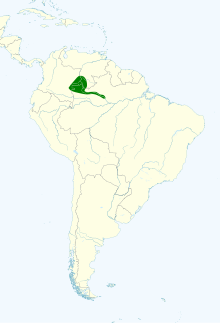Orinoco piculet
| Orinoco piculet | |
|---|---|
| Scientific classification | |
| Kingdom: | Animalia |
| Phylum: | Chordata |
| Class: | Aves |
| Order: | Piciformes |
| Family: | Picidae |
| Genus: | Picumnus |
| Species: | P. pumilus
|
| Binomial name | |
| Picumnus pumilus | |

| |
The Orinoco piculet (Picumnus pumilus) is a species of bird in the family Picidae. It is found in Brazil, Colombia, and Venezuela. Its natural habitat is subtropical or tropical moist lowland forests.
Description[]
The adult Orinoco piculet is about 9 cm (3.5 in) long. The upper parts are olive brown, sometimes lightly barred with tawny brown, and the underparts are cream or buff, boldly barred with dark brown. The head is brown speckled with white and has a white post-ocular streak. The male has faint yellow streaking or spotting on the fore crown but the female lacks this. The primary and secondary wing feathers are brown tipped with green, and the tail is black, the two central feathers having white inner webs and the outer feathers having a white bar near the tip. The beak is blackish and the legs grey. The call is a thin "seep-seep" and the song a rather longer suite of similar notes.[2]
Distribution and habitat[]
The Orinoco piculet is endemic to eastern Colombia and northwestern Brazil, and is likely to be present also in the adjacent part of southern Venezuela. Its habitat is open tropical humid rainforest, gallery forest, wooded savannah and clumps of trees and scrub at altitudes of up to 500 m (1,640 ft).[2]
Ecology[]
The Orinoco piculet is an active and acrobatic little bird, foraging at all levels of the canopy, sometimes in small mixed-species flocks, for termites, ants and other small invertebrates.[2] Its breeding habits are poorly known, but it may nest in November and December.[3]
Status[]
The Orinoco piculet has a wide range and is said to be generally uncommon. Its numbers are likely in decline as the tropical rainforest is gradually cleared, but this is not at such a fast rate as to make the International Union for Conservation of Nature rate it in a more threatened category than "least concern".[1]
References[]
- ^ a b BirdLife International (2016). "Picumnus pumilus". IUCN Red List of Threatened Species. 2016: e.T22680700A92873502. doi:10.2305/IUCN.UK.2016-3.RLTS.T22680700A92873502.en. Retrieved 15 November 2021.
- ^ a b c Gorman, Gerard (2014). Woodpeckers of the World: A Photographic Guide. Firefly Books. pp. 46–47. ISBN 177085309X.
- ^ Winkler, Hans; Christie, David A. (2010). Woodpeckers. Bloomsbury Publishing. p. 3. ISBN 978-1-4081-3504-4.
- IUCN Red List least concern species
- Picumnus (bird)
- Birds of the Colombian Amazon
- Birds of the Venezuelan Amazon
- Birds of the Amazon Basin
- Birds described in 1863
